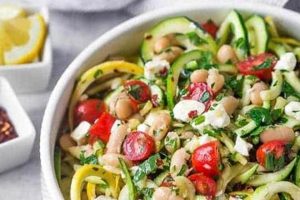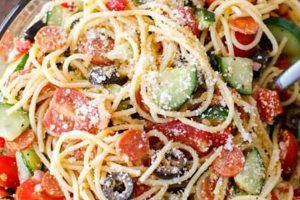A classic Caesar salad typically consists of romaine lettuce, croutons, Parmesan cheese, and a dressing made with ingredients such as garlic, lemon juice, olive oil, egg, Worcestershire sauce, and black pepper. Variations may include anchovies or other proteins. The croutons are often prepared by tossing cubed bread in olive oil and seasonings before baking or pan-frying until golden brown. The dressing is traditionally emulsified by hand, creating a creamy texture that coats the lettuce and other ingredients.
This specific approach to salad preparation holds a prominent place in culinary history, offering a balanced blend of flavors and textures. The crispness of the romaine, the richness of the cheese and dressing, and the satisfying crunch of the croutons create a harmonious culinary experience. Its enduring popularity speaks to its versatility, as it can be served as a starter, a light lunch, or a side dish. Furthermore, understanding the original composition provides a foundation for culinary exploration, allowing for creative adaptations while appreciating the dish’s historical context.
The following sections will delve deeper into the specific techniques and ingredient selections involved in crafting an authentic Caesar salad, exploring the nuances of emulsion creation, crouton preparation, and variations that maintain the spirit of this timeless dish.
Tips for a Traditional Caesar Salad
Achieving an authentic Caesar salad experience relies on attention to detail and a commitment to classic techniques. The following tips provide guidance on preparing this iconic dish with fidelity to its origins.
Tip 1: Use fresh, high-quality romaine lettuce. The lettuce should be crisp and cold, providing a refreshing foundation for the other ingredients. Avoid pre-shredded lettuce, as it can become limp and lose its textural appeal.
Tip 2: Prepare the croutons from scratch. Homemade croutons offer superior flavor and texture compared to store-bought alternatives. Use day-old bread for optimal results, ensuring a crispy exterior and a slightly chewy interior.
Tip 3: Emulsify the dressing by hand. While a blender can be used, the traditional method of whisking the ingredients together creates a superior emulsion, resulting in a creamy, cohesive dressing that clings beautifully to the lettuce.
Tip 4: Use authentic Parmesan cheese. Grated Parmigiano-Reggiano adds a distinct savory depth that enhances the overall flavor profile. Avoid pre-grated cheese, which often contains cellulose and other additives that can compromise the flavor.
Tip 5: Add the dressing just before serving. Tossing the salad with the dressing immediately prior to serving prevents the lettuce from wilting and maintains the crispness of the croutons.
Tip 6: Consider using anchovy paste or fillets for a more pungent flavor. While optional, anchovies contribute a salty, umami element that complements the other ingredients and aligns with many traditional preparations.
Tip 7: Use freshly squeezed lemon juice. Bottled lemon juice often contains preservatives and lacks the bright, vibrant flavor of fresh juice, which is essential for a balanced dressing.
By adhering to these guidelines, one can create a Caesar salad that embodies the essence of this culinary classic. The combination of fresh ingredients, proper techniques, and attention to detail results in a dish that is both satisfying and historically resonant.
These insights into ingredient selection and preparation methods provide a comprehensive understanding of the elements that contribute to a truly exceptional Caesar salad. By following these recommendations, one can experience the timeless appeal of this iconic dish.
1. Romaine Lettuce
Romaine lettuce is fundamental to a traditional Caesar salad, providing the foundational layer upon which the other ingredients build. Its distinct characteristics are essential to the salad’s overall success, offering both texture and flavor that complement the richness of the dressing and the crunch of the croutons.
- Crisp Texture:
Romaine’s sturdy leaves offer a satisfying crunch that contrasts with the creamy dressing. This textural interplay is a hallmark of the Caesar salad experience. The robust structure of romaine also prevents the leaves from wilting quickly under the dressing, maintaining a pleasant texture throughout the meal.
- Slightly Bitter Flavor:
Romaine possesses a subtle bitterness that balances the richness of the dressing and the saltiness of the Parmesan cheese. This nuanced flavor profile adds complexity and prevents the salad from becoming overly rich. The slight bitterness also enhances the other flavors, creating a more harmonious taste experience.
- Structural Integrity:
The elongated, cup-shaped leaves of romaine are ideal for holding the dressing and other ingredients. This structural advantage allows for even distribution of flavors throughout the salad. The robust leaves can also be grilled or lightly charred, adding another layer of flavor and texture to the dish.
- Historical Significance:
The use of romaine lettuce aligns with the historical origins of the Caesar salad. While some modern variations may incorporate other lettuces, romaine remains the traditional choice, contributing to the authenticity of the dish. Adhering to this tradition preserves the integrity and historical context of the Caesar salad.
These characteristics of romaine lettuce contribute significantly to the classic Caesar salad’s enduring appeal. Its crisp texture, subtly bitter flavor, structural integrity, and historical relevance make it an irreplaceable component of this iconic dish, ensuring a balanced and flavorful culinary experience true to the original recipe.
2. Croutons
Croutons contribute significantly to the textural and flavor profile of a traditional Caesar salad, differentiating it from other lettuce-based salads. Their presence provides a crucial counterpoint to the crisp romaine and creamy dressing, adding a dimension that elevates the overall sensory experience. An understanding of their role and preparation is essential for achieving authenticity.
- Texture and Contrast:
Croutons introduce a satisfying crunch that contrasts with the smooth dressing and crisp lettuce. This textural interplay is a defining characteristic of the traditional Caesar salad, adding complexity and preventing a monotonous mouthfeel. Properly prepared croutons offer a delicate balance between a crisp exterior and a slightly yielding interior.
- Flavor Enhancement:
The toasting or frying process develops the bread’s inherent flavors, creating subtle notes of toasted wheat and enhancing the overall savory profile of the salad. The croutons can also absorb some of the dressing, further intensifying their flavor contribution and distributing it throughout the salad.
- Traditional Preparation Methods:
Traditional Caesar salad croutons are typically made from cubed, day-old bread, tossed in olive oil and seasonings, then baked or pan-fried until golden brown. This method ensures optimal flavor and texture, aligning with the historical preparation of the dish. Avoiding pre-made, seasoned croutons is crucial for maintaining authenticity.
- Historical Context and Variations:
While the exact origin of croutons in Caesar salad is debated, their inclusion has become a standard element of the traditional recipe. Variations exist in terms of bread type and seasoning, but the core principle of adding a toasted bread element remains consistent. Understanding this historical context reinforces the importance of croutons in achieving a truly traditional Caesar salad.
The careful preparation and inclusion of croutons are integral to experiencing a Caesar salad as originally intended. Their contribution extends beyond mere texture, enhancing the flavor profile and reflecting the historical development of this classic dish. By understanding these nuances, one can appreciate the crucial role croutons play in a truly authentic and satisfying Caesar salad experience.
3. Parmesan Cheese
Parmesan cheese, specifically Parmigiano-Reggiano, plays a crucial role in defining the flavor profile of a traditional Caesar salad. Its inclusion is not merely customary but integral to the balance of textures and tastes that characterize the dish. An understanding of its contributions is essential for appreciating the nuances of this classic preparation.
- Sharp, Savory Flavor:
Parmigiano-Reggiano provides a distinct umami richness and a sharp, salty counterpoint to the other ingredients. This complexity of flavor distinguishes it from other cheeses and enhances the overall savoriness of the salad. The aging process contributes to the depth of flavor, creating nutty and slightly sweet notes that complement the other components.
- Hard Texture and Grating Properties:
The hard texture of Parmigiano-Reggiano allows it to be grated finely, creating a delicate texture that distributes evenly throughout the salad. This ensures that the flavor is dispersed consistently, enhancing every bite. The fine grating also allows the cheese to meld with the dressing, contributing to the overall creamy texture.
- Traditional Authenticity:
The use of Parmigiano-Reggiano aligns with the historical origins of the Caesar salad, reflecting a commitment to authentic ingredients and preparation. Substituting other cheeses compromises the intended flavor profile and detracts from the traditional experience. Using genuine Parmigiano-Reggiano preserves the historical integrity of the dish.
- Nutritional Value and Culinary Applications:
Beyond its flavor contribution, Parmigiano-Reggiano offers nutritional benefits, being a good source of calcium and protein. Its culinary versatility extends beyond Caesar salad, showcasing its adaptability in various Italian dishes. This further underscores its value as a key ingredient.
The inclusion of Parmigiano-Reggiano is not merely a traditional element; it’s a defining component that contributes significantly to the Caesar salad’s enduring appeal. Its sharp, savory flavor, unique textural qualities, and historical relevance make it an essential ingredient for anyone seeking an authentic and flavorful Caesar salad experience. Understanding the nuances of this cheese allows for a deeper appreciation of the carefully balanced flavors and textures that characterize this classic dish.
4. Coddledeggs
Coddled eggs, while sometimes omitted in modern interpretations, hold a significant historical connection to traditional Caesar salad preparations. Their inclusion impacts both the dressing’s texture and flavor, contributing to the authentic characteristics that define the classic dish. Understanding their role provides valuable insight into the nuances of a truly traditional Caesar salad.
- Emulsification and Texture:
The gently cooked yolk of a coddled egg acts as an emulsifier, binding the oil and acidic elements of the dressing together. This creates a smooth, creamy texture that coats the romaine lettuce effectively, contributing to the luxurious mouthfeel characteristic of a traditional Caesar salad. Without the egg, the dressing is more likely to separate and lack the desired consistency.
- Flavor and Richness:
The coddled egg yolk adds a subtle richness and depth of flavor to the dressing, complementing the other ingredients. The gentle cooking process preserves the yolk’s delicate flavor, preventing it from becoming overpowering. This nuanced contribution enhances the overall balance and complexity of the salad’s flavor profile.
- Historical Authenticity:
The use of a coddled egg aligns with the historical origins of the Caesar salad, reflecting the traditional preparation methods employed when the dish was first created. While some contemporary recipes omit the egg due to concerns about raw egg consumption, understanding its historical significance provides context for appreciating the authentic preparation of the salad.
- Safety and Modern Adaptations:
Due to potential health risks associated with consuming raw or undercooked eggs, some modern adaptations of the Caesar salad utilize pasteurized eggs or alternative emulsifying agents. While these adaptations offer a safer alternative, they deviate from the traditional recipe. Those seeking the authentic experience may choose to use carefully sourced, very fresh eggs and coddle them precisely to minimize risk.
The inclusion of a coddled egg contributes significantly to the textural and flavor profile of a truly traditional Caesar salad. While modern safety concerns have led to adaptations and omissions, understanding the egg’s historical role and its impact on the dressing provides a deeper appreciation for the authentic preparation of this classic dish. By considering these nuances, one can make informed decisions about ingredient selection and preparation methods, ultimately determining the level of adherence to tradition desired in their Caesar salad experience.
5. Olive Oil
Olive oil constitutes a foundational element within traditional Caesar salad recipes, contributing significantly to both flavor and texture. Its inherent properties interact with other ingredients, creating a cohesive and balanced sensory experience. This exploration delves into the multifaceted role of olive oil in achieving an authentic Caesar salad.
High-quality extra virgin olive oil imparts a distinct fruity and peppery flavor that complements the other ingredients. This flavor profile enhances the complexity of the dressing, balancing the acidity of the lemon juice and the sharpness of the Parmesan cheese. Furthermore, olive oils viscosity contributes to the emulsion’s stability, ensuring a creamy, cohesive dressing that clings to the romaine lettuce. This emulsification process is crucial for achieving the desired texture and even distribution of flavor. For example, a robust Tuscan olive oil provides a peppery note, while a delicate Ligurian olive oil offers a milder, fruitier flavor, each contributing a unique nuance to the final dish.
The practical significance of selecting appropriate olive oil becomes apparent in the final product. The quality and type of olive oil directly influence the overall flavor profile and the emulsification process. Choosing an inferior oil or using an incorrect quantity can result in a dressing that is either too oily or lacks the desired richness and flavor complexity. An understanding of olive oils function within the recipe allows for informed decisions regarding selection and quantity, ensuring an authentic and flavorful Caesar salad experience. This knowledge translates directly to improved culinary outcomes and a deeper appreciation for the role of each ingredient in the traditional preparation.
6. Lemon Juice
Lemon juice provides essential acidity to a traditional Caesar salad, balancing the richness of the olive oil and other ingredients. This acidity is crucial for achieving the characteristic bright, vibrant flavor profile that distinguishes the Caesar salad. The citric acid in lemon juice also acts as a natural preservative, helping to maintain the salad’s freshness. Furthermore, lemon juice contributes to the emulsification process, helping to bind the oil and egg yolk together in a stable dressing. For instance, using freshly squeezed lemon juice as opposed to bottled varieties results in a noticeably brighter, more complex flavor profile. The difference highlights the importance of fresh, high-quality ingredients in achieving an authentic result.
The quantity of lemon juice used can significantly impact the overall balance of the salad. Too little lemon juice can result in a dressing that is overly rich and heavy, while too much can create an excessively tart flavor. The ideal balance allows the other flavors, such as the Parmesan cheese and garlic, to shine through without being overwhelmed. Practical applications of this understanding include adjusting the amount of lemon juice based on the specific olive oil used and personal preference. For example, a more robust olive oil might require a slightly higher proportion of lemon juice to balance its intensity.
Achieving the correct balance of lemon juice within a traditional Caesar salad dressing is paramount to achieving an authentic and enjoyable culinary experience. The interplay between acidity, richness, and other flavor components underscores the importance of precise ingredient selection and preparation. Challenges can arise from variations in lemon acidity and individual palates, necessitating careful adjustments to achieve the desired harmony. This attention to detail reflects a commitment to the historical integrity and intended flavor profile of the traditional Caesar salad.
7. Worcestershire Sauce
Worcestershire sauce contributes a complex depth of flavor to traditional Caesar salad, a nuanced element often overlooked. Composed of a fermented base of anchovies, vinegar, molasses, tamarind, onions, garlic, and other spices, it introduces a unique umami character that complements the other ingredients. This umami note, derived from the anchovies and fermentation process, enhances the savory aspects of the cheese and balances the brighter notes of the lemon juice. Historically, Worcestershire sauce provided a readily available means of incorporating the savory essence of anchovies without requiring fresh fillets, reflecting resourcefulness in culinary practice. For example, the subtle salty and fermented notes of Worcestershire sauce can amplify the inherent flavors of the Parmesan, creating a synergistic interplay that elevates the overall taste experience.
The quantity of Worcestershire sauce used requires careful consideration, as its potent flavor can easily overpower the delicate balance of the dressing. Even small variations in the amount used can significantly alter the final result. A few dashes typically suffice to provide the desired savory depth without dominating the other flavors. Practical application of this knowledge involves starting with a conservative amount and adjusting incrementally to taste. Overuse can lead to an excessively salty and pungent dressing, masking the other nuanced flavors. Furthermore, variations in Worcestershire sauce brands exist, each possessing its own specific flavor profile, impacting the final flavor of the Caesar salad. Discerning palates might prefer specific brands that align with their desired taste outcome, further highlighting the practical significance of understanding this ingredient’s contribution.
Achieving the appropriate balance of Worcestershire sauce is crucial for a successful traditional Caesar salad. Its inclusion contributes significantly to the complexity and depth of the dressing, but judicious use is essential. Challenges arise from the sauce’s concentrated flavor and brand variations, necessitating careful attention and adjustments based on personal preference and specific ingredient combinations. The historical context, combined with an understanding of its impact on the final dish, allows for a more nuanced and informed approach to preparing a truly authentic and balanced Caesar salad. This understanding translates directly to improved culinary outcomes and a deeper appreciation for the traditional elements of the dish.
Frequently Asked Questions
This section addresses common inquiries regarding the preparation and historical context of traditional Caesar salad.
Question 1: What distinguishes a traditional Caesar salad from other variations?
Traditional Caesar salad emphasizes specific ingredients and techniques: romaine lettuce, coddled egg, freshly grated Parmigiano-Reggiano, homemade croutons, and a hand-emulsified dressing with Worcestershire sauce. Modern variations often deviate from these core components.
Question 2: Is raw egg essential for an authentic Caesar dressing?
Historically, a coddled egg (briefly cooked) emulsifies the dressing, contributing to its creamy texture and richness. While essential for traditional authenticity, modern adaptations often omit or substitute the egg due to food safety concerns.
Question 3: Can bottled lemon juice be used in a traditional Caesar dressing?
Freshly squeezed lemon juice is preferred for its brighter, more vibrant flavor, which significantly impacts the dressing’s overall quality. Bottled lemon juice often contains preservatives that can detract from the authentic taste.
Question 4: Are anchovies required in a traditional Caesar salad?
While not a mandatory ingredient, anchovies, either in paste or fillet form, contribute a savory, umami depth that aligns with many historical preparations. Worcestershire sauce, which contains anchovies, often provides this element in traditional recipes.
Question 5: What type of bread should be used for traditional croutons?
Day-old, crusty bread, such as a baguette or Italian loaf, is ideal for croutons. Its texture allows for optimal crispness and a slightly chewy interior when properly prepared.
Question 6: How does one achieve the creamy texture of a traditional Caesar dressing without a blender?
The traditional method involves whisking the ingredients vigorously by hand, gradually incorporating the olive oil to create a stable emulsion. This method, while requiring more effort, often yields a superior texture compared to using a blender.
Understanding these nuances provides clarity regarding traditional Caesar salad preparation and allows for informed decisions regarding ingredient selection and technique. Adhering to these guidelines ensures a historically informed and flavorful culinary experience.
The following section provides step-by-step instructions for preparing a traditional Caesar salad.
Traditional Caesar Salad
Exploration of “Caesar salad recipe traditional” reveals a dish defined by specific ingredients and techniques. Romaine lettuce provides the crisp foundation. Homemade croutons contribute textural contrast. Parmigiano-Reggiano delivers sharp, savory notes. A coddled egg, historically key, emulsifies the dressing, creating a creamy texture. Olive oil, lemon juice, and Worcestershire sauce combine to form a balanced, complex dressing. These elements work synergistically, offering a harmonious blend of flavors and textures.
Understanding the historical context and specific components of a traditional Caesar salad allows for informed culinary choices. Appreciating the nuances of ingredient selection and preparation ensures an authentic experience, preserving a culinary legacy for future generations. This knowledge empowers culinary enthusiasts to replicate and appreciate this classic dish in its truest form, fostering a deeper connection to culinary history and tradition.






